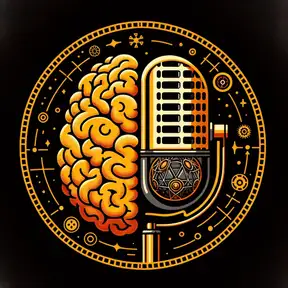The Psychology of Everyday Aesthetics: Why Your Surroundings Shape How You Feel
The Psychology of Everyday Aesthetics: How Our Surroundings Shape Our Well-being
In this episode of PsyberSpace, host Leslie Poston explores the psychological impact of everyday aesthetics on our emotions, focus, and overall well-being. From cozy cafes to well-lit offices, Leslie delves into the science behind how environmental cues like color, light, form, and texture affect our mental state and cognitive performance. The episode also discusses the importance of creating supportive environments, especially for those who are neurodivergent, chronically ill, or recovering from trauma. Learn how to leverage aesthetic principles to create spaces that promote safety, comfort, and productivity. This episode emphasizes that aesthetics aren't frivolous but functional, and they play a crucial role in our daily lives and mental health.
00:00 Introduction to PsyberSpace
00:23 The Cafe Effect: How Environment Enhances Experience
01:01 The Psychology of Everyday Aesthetics
02:25 The Science Behind Aesthetic Responses
04:12 Environmental Psychology and Neuroaesthetics
08:33 The Impact of Light, Color, and Texture
11:11 Aesthetics and Memory: Emotional Anchors
17:31 Designing for Wellbeing: Practical Tips
20:33 Conclusion: Aesthetics as Functional and Essential
In this episode of PsyberSpace, host Leslie Poston explores the psychological impact of everyday aesthetics on our emotions, focus, and overall well-being. From cozy cafes to well-lit offices, Leslie delves into the science behind how environmental cues like color, light, form, and texture affect our mental state and cognitive performance. The episode also discusses the importance of creating supportive environments, especially for those who are neurodivergent, chronically ill, or recovering from trauma. Learn how to leverage aesthetic principles to create spaces that promote safety, comfort, and productivity. This episode emphasizes that aesthetics aren't frivolous but functional, and they play a crucial role in our daily lives and mental health.
00:00 Introduction to PsyberSpace
00:23 The Cafe Effect: How Environment Enhances Experience
01:01 The Psychology of Everyday Aesthetics
02:25 The Science Behind Aesthetic Responses
04:12 Environmental Psychology and Neuroaesthetics
08:33 The Impact of Light, Color, and Texture
11:11 Aesthetics and Memory: Emotional Anchors
17:31 Designing for Wellbeing: Practical Tips
20:33 Conclusion: Aesthetics as Functional and Essential
References
Browning, W. D., Ryan, C. O., & Clancy, J. O. (2014). 14 patterns of biophilic design. Terrapin Bright Green.
Cela-Conde, C. J., Marty, G., Maestú, F., Ortiz, T., Munar, E., Fernández, A., Roca, M., Rosselló, J., & Quesney, F. (2004). Activation of the prefrontal cortex in the human visual aesthetic perception. Proceedings of the National Academy of Sciences, 101(16), 6321–6325.
Chatterjee, A., & Vartanian, O. (2014). Neuroaesthetics. Trends in Cognitive Sciences, 18(7), 370–375.
Cupchik, G. C. (2009). Viewing artworks: Contributions of cognitive control and perceptual facilitation to aesthetic experience. Brain and Cognition, 70(1), 84–91.
Kaplan, R., & Kaplan, S. (1989). The experience of nature: A psychological perspective. Cambridge University Press.
Kaplan, S. (1995). The restorative benefits of nature: Toward an integrative framework. Journal of Environmental Psychology, 15(3), 169–182.
Kawabata, H., & Zeki, S. (2004). Neural correlates of beauty. Journal of Neurophysiology, 91(4), 1699–1705.
Kellert, S. R., Heerwagen, J., & Mador, M. (Eds.). (2008). Biophilic design: The theory, science and practice of bringing buildings to life. John Wiley & Sons.
Ohly, H., White, M. P., Wheeler, B. W., Bethel, A., Ukoumunne, O. C., Nikolaou, V., & Garside, R. (2016). Attention restoration theory: A systematic review of the attention restoration potential of exposure to natural environments. Journal of Toxicology and Environmental Health, Part B, 19(7), 305–343.
Ulrich, R. S. (1984). View through a window may influence recovery from surgery. Science, 224(4647), 420–421.
Ulrich, R. S. (1991). Stress recovery during exposure to natural and urban environments. Journal of Environmental Psychology, 11(3), 201–230.
Zeki, S. (1999). Inner vision: An exploration of art and the brain. Oxford University Press.
Zeki, S., Romaya, J. P., Benincasa, D. M. T., & Atiyah, M. F. (2014). The experience of mathematical beauty and its neural correlates. Frontiers in Human Neuroscience, 8, 68.
Zeki, S., Chén, O. Y., & Romaya, J. P. (2020). Neuroaesthetics: The art, science, and brain triptych. In A. Chatterjee & E. Cardillo (Eds.), Brain, beauty & art: Essays bringing neuroaesthetics into focus (pp. 1–28). Oxford University Press.
★ Support this podcast ★
Creators and Guests


